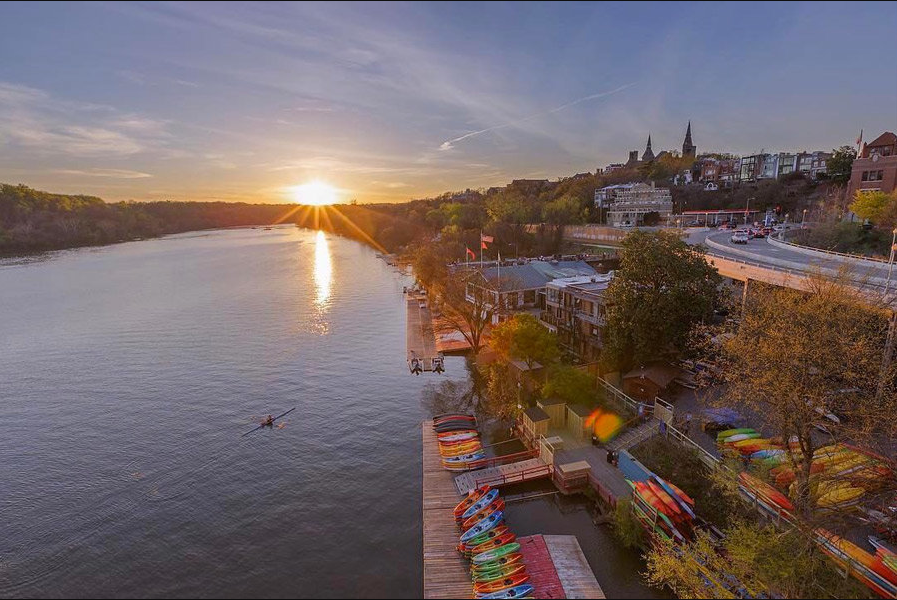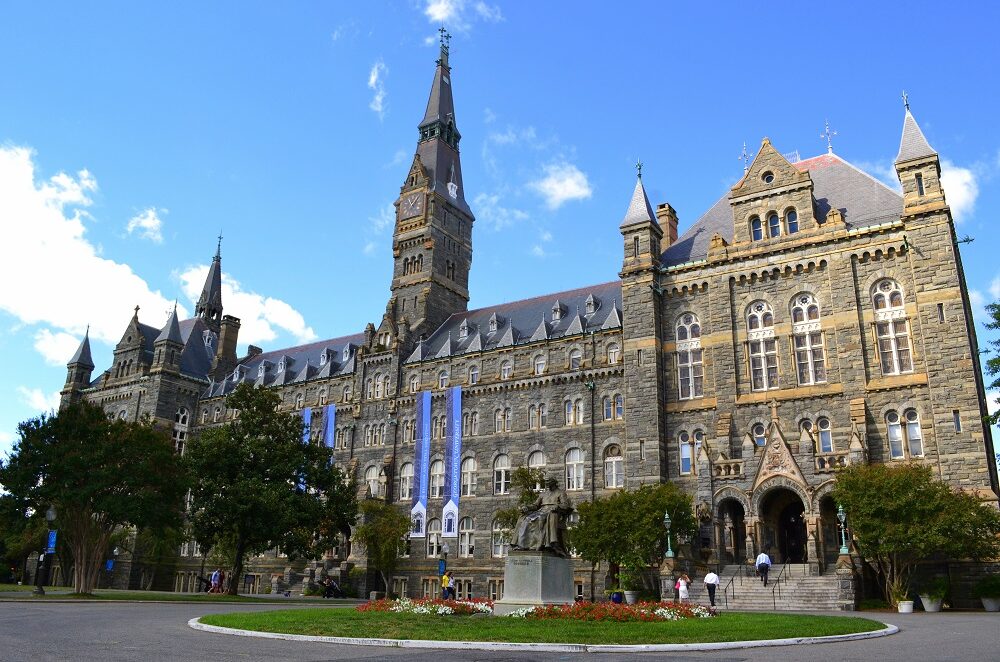Capital of Guyana
The capital town of Guyana is Georgetown. It is the capital city of Guyana and its main port. It is located within the Demerara-Mahaica region, facing the Atlantic Ocean, at the mouth of the Demerara River. Its population was 255,000 people in 2010. Georgetown (also known as “Garden City” for its beauty and natural wealth) represents the economic and administrative center of this country.
History
The capital town of Guyana is Georgetown in the past, this city founded by Britons in 1781 underwent several modifications, such as being controlled by French, pass into the hands of Dutch and be baptized as Seabrook. Finally, in 1812 the area was recovered by the British and regained its original name: Georgetown.
The site was originally chosen as a fortress to protect the first Dutch settlements of the Demurer River. The city is located below sea level and is protected from the Atlantic Ocean by the dam that was built in two phases. The first phase, up to the Rotunda, was completed in 1860 and the second phase, which extends to Kitty, was carried out from 1872 to 1882. At the western end of the sea wall is a kiosk that was built in 1903
The capital town of Guyana is Georgetown has more than two hundred years. In 1781, the British military administrator of the Demerara Colony, Lieutenant Colonel Robert Kingston, established St. George’s Fort as his headquarters in a part of the area now known as Georgetown. The French gained control of the colony of Demerara in 1782. They demolished Fort St. George and built a new center called Longchamps (La Nouvelle-Ville). In 1784, the Dutch once again took control of the colony of Demerara and changed the name of their colonial capital from Longchamps to Stabroek.

In 1796, the Dutch control of Demerara passed to the British who maintained it until 1966, except for a brief period from 1802 to 1803 when the Dutch had control. Stabroek was renamed George Town in 1812, after the British monarch, King George IV. George Town became the city of Georgetown by “Royal” court order in 1842. The boundaries of Georgetown were expanded in 1970 to include Sofia, Lilendaal, Pattensen, Turkeyen and Cummings Lodge, to the east on the east coast, Ruimveldt,
The current area of Georgetown is about 40 square kilometers compared to about 6 square kilometers before expansion in 1970 under the Municipal and District Council Laws. The city of Georgetown is presented in a rectangular pattern with tree-lined avenues, drainage canals and kokers. Most of the historic buildings of the city are wooden in construction.
Interesting Facts about Georgetown
Geography
Georgetown is located within the region of Demerara-Mahaica, facing the Atlantic Ocean at the mouth of the Demurer River, one of the many rivers flowing down from the upper parts of Guyana, cooling the entire coastal plain of the Atlantic… With a population Of 255,000 inhabitants (to the year 2010) is the largest city in Guyana. The city has a large number of tree-lined streets and avenues, as well as many colonial wooden buildings, markets and a picturesque Dutch and Victorian colonial architecture derived from its days as Dutch and English colony.
Because of its importance, the buildings it houses and the level of activity that takes place there, it can be said that Georgetown (also known as “Garden City” for its beauty and natural wealth) represents the economic and administrative center of this country.
Do you know about the capital city of Guinea ?
Weather
The climate is warm and humid, quite rainy; the rainy season lasts from May to July. There is a second rainy season from November to January. Temperatures do not vary much throughout the year.
Economy
The Cooperative Republic of Guyana has its largest city in Georgetown as well as the nation’s capital. It is located in front of the Atlantic Ocean, constituting the main port of that country where it exports: sugar, bauxite, gold and diamonds.
As capital, Georgetown has Guyana’s buildings, political and governmental departments: parliament, legislative building, court of appeal and court of law. It also contains the most important businesses and the University of Guyana.
It is a city of importance not only for Guyana but also for the Caribbean. Within the metropolitan area are the CARICOM headquarters which is the center of Caribbean economic governance.
Tourism
The tourist attractions offered by this port region are several but, beyond its charms, one can not fail to take into account that here, as in many places in the world, insecurity and acts of violence occur every day, reason For which you have to take all possible precautions and not risk visiting dangerous areas or strolling at night. The design of the streets, the colonial architecture of the 19th century, the system of walls and canals built to stop the flow of water, the Water St. market, the picturesque Seabrook market; the Botanical Garden and St. George’s Cathedral give it to the city, without a doubt, a seductive profile at the tourist level.
Transport
In Georgetown there is a ferry or barge, the Harbor Bridge Demerara and recently built roads. In addition, the state works on repairing all roads in the country to help transport the population.Cheddi Jagan International Airport is the city’s air transport hub, located on the right bank of the Demerara River , 41 kilometers south of Georgetown. Through it international flights are made to the cities of New York, Miami, Toronto, Bridgetown, Port of Spain and Paramaribo. There is also a regular bus service between Georgetown and Boa Vista in Brazil, daily boat transportation to Paramaribo, Suriname via the Courantyne River.

Culture
The city of Georgetown is a city of dynamic and elegant character that reflects an exceptional cultural history. In the capital of Guyana you can see wide tree – lined avenues, beautiful lilies covering the channels, and many works and houses dating from the eighteenth century and nineteenth, designed by Dutch Stabroek.
A tour of Georgetown offers several examples of the colonial architecture of the city (18th and 19th centuries), its monuments, statues, temples, markets, gardens and museums. Some of which are listed below:
Seabrook Market sometimes referred to as the Great Market, is close to an open-air market where slaves were allowed to sell bananas only on Sundays, from 1792. The market was named after an early solution at the mouth of the Demerara River. This settlement was named in 1783 after Seabrook Nicolas Geelvinck, Lord of Capiscum, Bakum and Stabroek, the then president of the Company of the Dutch West Indies. The current structure of wood, concrete, zinc and iron occupies about 0.9 hectares of land and water. The cornerstone for the market was laid on July 17, 1880 by Mrs. Kortwright, the Governor’s wife, Cornelius Cartwright. Stabroek Market was officially inaugurated on November 1, 1881. The famous four-sided clock, which represents almost 31 meters above ground level has been manufactured in the United States and installed in its tower above the market in 1881. The market was designed and built by two US companies. Once described as Bizarre Bazaar, anything from gold jewelry to fruits and vegetables can be found in the market. Other municipal markets are Bourda (1880),
Parliament building, also known as public buildings, houses of the Guyana Legislature and National Assembly and was designed by Joseph Hadfield. The first stone was laid in 1829 and the building was completed in 1834.
The High Court, also called the Law Courts of Victoria, it was designed by César Castellani and opened 24 of maypole of 1887. In front of the Supreme Court is a statue of Queen Victoria, which was released on September 4, 1894 by the governor, Sir Charles Lees. The statue was moved to the City Engineer Department complex in 1990 and later returned to the Supreme Court compound.
The National Museum is located on North Road in a complex of buildings that was inaugurated in 1951. The museum’s collections are already in the Carneige building. Other museums in the city include the National Military Museum at Ayanganna Camp, Tomas Lands, the Police Museum at Police Headquarters, Leary Eva, and the Museum of African Art at Barima Avenue. The Monument to the ¹ of the Non-Aligned Movement on the road to the company, east of the hand in the construction of the Hand, is a tribute to the founding leaders of the Movement of Non-Aligned Countries. It was premiered in 1972 by Guyana’s first President, Arthur Chung, and includes busts from Gamal Abd Al-Nasser of Egypt ,
The Cenotaph Memorial or War , at the southern end of Main Street, is near the Bank of Guyana and the National Library building. The marble monument, about 4.5 meters high, is a monument to the fallen in the world wars first and second.
The National Library , formerly known as the Public Library of the Georgetown Free Library, was inaugurated in 1909 . The construction was funded by a Scottish-American born to philanthropist Andrew Carnegie , of whom the building was named.
The State House is the official residence of the President of Guyana. The original structure was built in 1845 and was known as the Government House, the home of the Governors of British Guiana for over 100 years.
The Monument to the Liberation , was discovered in the esplanade of the Umana Yana during 1974 . The monument in commemoration and solidarity with the Movement of African liberation and is composed of five pillars of the Green Heart of irregular height and a granite slab with stones around its base.
The lighthouse, brick and concrete structure about 31 meters high, was built by the British in 1830 near the mouth of the river Demerara. It is the only lighthouse in the country and guide for ships in the port of Georgetown with its rotating light.
The National Independence Monument in Brickdam near Vlissengen Road, is a gift to the people of Guyana, the Demerara Bauxite Company (Demba) to commemorate the Independence of Guyana Britain the 26 of maypole of 1966 . The structure, in the form of an arc, consists of three tubes of aluminum from bauxite Guyana mounted on a base of quartz . The bow was designed by a Canadian engineer, Edric Klak .
The tropical gardens of Georgetown are considered the best in the world, and of course, if this country hosts a huge amount of native species that come from the same jungle . Through the city you can find the colorful markets of the East Indies
Religion
St. George ‘s Cathedral is the mother church of the Anglican Diocese in Guyana. It is one of the tallest, independent wooden buildings in the world with its tower over 40 feet high. The building was designed by Sir Arthur Bloomfield and the first stone was placed on November 21 , 1889 . The cathedral was inaugurated by Bishop William Percy Austin on 24 as August as 1892 and dedicated by Bishop P. Swab on 8 November as 1894.











